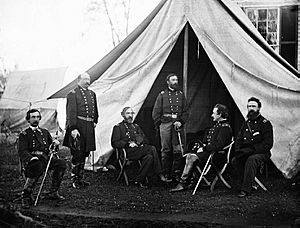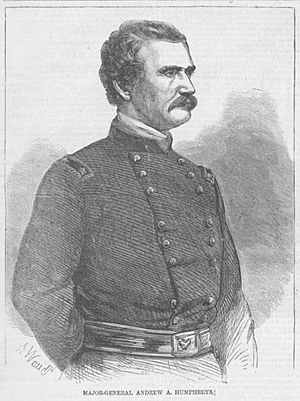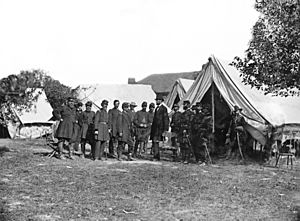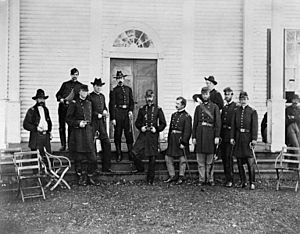Andrew A. Humphreys facts for kids
Quick facts for kids
Andrew A. Humphreys
|
|
|---|---|

Andrew A. Humphreys
|
|
| Born | November 2, 1810 Philadelphia, Pennsylvania |
| Died | December 27, 1883 (aged 73) Washington, D.C. |
| Place of burial |
Congressional Cemetery
|
| Allegiance | |
| Service/ |
United States Army Union Army |
| Years of service | 1831–1836, 1838–1879 |
| Rank | |
| Commands held | II Corps US Army Corps of Engineers |
| Battles/wars | Seminole Wars American Civil War |
| Spouse(s) | Rebecca Humphreys Hollingsworth |
| Relations |
|
| Other work | Authored Report upon the physics and hydraulics of the Mississippi River (1861) From Gettysburg to the Rapidan (1883) and The Virginia Campaign of '64 and '65 (1883) |
| Signature | |
Andrew Atkinson Humphreys (November 2, 1810 – December 27, 1883) was an important figure in American history. He was a United States Army officer and a skilled civil engineer. During the American Civil War, he became a Union General. He held several key roles in the Army of the Potomac, including leading a division, serving as chief of staff, and commanding a corps. Later, he became the Chief Engineer for the U.S. Army.
Early Life and Career
Andrew Atkinson Humphreys was born in Philadelphia, Pennsylvania. His family had a long history of serving the country. His grandfather, Joshua Humphreys, was known as the "Father of the American Navy." He designed the first U.S. warships, including the famous USS Constitution ("Old Ironsides"). Andrew's father, Samuel Humphreys, also designed ships, including the very large USS Pennsylvania.
Andrew went to the United States Military Academy, or West Point, when he was 17. He graduated in 1831. After graduation, he joined the army and saw his first combat experience during the Seminole Wars in Florida.
Later, Humphreys became a captain in the engineer corps. He spent ten years studying the Mississippi River Delta. His goal was to find ways to prevent flooding and make the river deeper for ships. He also worked on the Pacific Railroad Surveys from 1853 to 1857. This project aimed to find the best route for the First transcontinental railroad across the country. Before the Civil War, Humphreys was considered a top American scientist.
Civil War Service
When the Civil War began, Humphreys was promoted to major. He became the chief engineer for Maj. Gen. George B. McClellan's Army of the Potomac. He helped plan defenses for Washington, D.C. In 1862, he joined McClellan for the Peninsula Campaign. He was promoted to brigadier general and later commanded the 3rd Division in the V Corps.
At the Battle of Fredericksburg, Humphreys' division made a brave charge against strong Confederate fire. He personally led his troops from the very front, even after two of his horses were shot from under him. His clothes were hit by bullets, but he was not hurt. His commander praised his bravery and leadership, especially since his troops were new to combat.
Even though his men respected his courage, Humphreys was known for being a strict leader. They sometimes called him "Old Goggle Eyes" because of his eyeglasses.


At the Battle of Chancellorsville, Humphreys' division faced heavy fighting. In May 1863, he was moved to command the 2nd Division in the III Corps. Just before the Battle of Gettysburg, General George Meade asked Humphreys to be his chief of staff. Humphreys initially said no because he wanted to keep leading his division.
At Gettysburg, on July 2, 1863, Humphreys' division was in a very dangerous position. They were attacked by a large Confederate force. Despite being outnumbered and in a difficult spot, Humphreys and his men fought bravely. His division suffered heavy losses but eventually regrouped.
After Gettysburg, Humphreys was promoted to major general. He then agreed to become General Meade's chief of staff. He served in this role through several campaigns, including the Overland Campaign and the Siege of Petersburg in 1864. In November 1864, he took command of the II Corps. He led this corps through the rest of the siege and during the pursuit of General Robert E. Lee until Lee surrendered at Appomattox Court House. For his service, he received honorary promotions, called "brevets," for his bravery at Gettysburg and the Battle of Sayler's Creek.
After the War
After the Civil War, Humphreys became a permanent brigadier general and the Chief of Engineers in 1866. In this role, he was in charge of many important projects. His team oversaw a huge increase in river and harbor work across the country. He held this position until he retired in 1879.
Humphreys received an honorary law degree from Harvard University in 1868. He was also one of the founders of the National Academy of Sciences. He wrote several books, including an important scientific report on the Mississippi River and personal accounts of the Civil War. He passed away in Washington, D.C., and is buried in the Congressional Cemetery.
Several places have been named in his honor. A military base in Virginia, Camp A. A. Humphreys, was named after him during World War I. Although the base was later renamed Fort Belvoir, a part of it, the United States Army Corps of Engineers Humphreys Engineer Center, still carries his name. Also, Humphreys Peak, the highest mountain in Arizona, is named for him.
See also
- List of American Civil War generals (Union)
Images for kids



